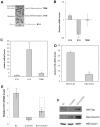CCHCR1 interacts specifically with the E2 protein of human papillomavirus type 16 on a surface overlapping BRD4 binding
- PMID: 24664238
- PMCID: PMC3963918
- DOI: 10.1371/journal.pone.0092581
CCHCR1 interacts specifically with the E2 protein of human papillomavirus type 16 on a surface overlapping BRD4 binding
Abstract
The Human Papillomavirus E2 proteins are key regulators of the viral life cycle, whose functions are commonly mediated through protein-protein interactions with the host cell proteome. We identified an interaction between E2 and a cellular protein called CCHCR1, which proved highly specific for the HPV16 genotype, the most prevalent in HPV-associated cancers. Further characterization of the interaction revealed that CCHCR1 binds the N-terminal alpha helices of HPV16 E2 N-terminal domain. On this domain, the CCHCR1 binding interface overlaps that of BRD4, a key mediator of E2 transcriptional activity. Consequently a physical competition occurs between the two proteins for the binding to HPV16 E2, and CCHCR1 interferes with BRD4-mediated enhancement of E2-dependent transcription. In addition, we showed that the interaction with CCHCR1 induced a massive redistribution of HPV16 E2, from a predominantly nuclear to a cytoplasmic localization in dot-like structures, where E2 perfectly co-localizes with CCHCR1. Such a cytoplasmic docking likely interferes with the nuclear functions of HPV16 E2. Upon co-expression of BRD4 and CCHCR1, E2 accumulates both in the nucleus and in the cytoplasm, indicating that for HPV16, both sub-cellular localization and transcriptional functions of E2 may depend on the proportion of both factors within the cell. We provided evidence of a strong induction of the keratinocyte differentiation marker K10 by HPV16 E2, and showed that this activation is compromised by the interaction with CCHCR1. The specific interaction described here could thus impact on the pathogenesis of HPV16. We propose that it could underlie some specific traits of HPV16 infection, such as an enhanced propensity to give rise to lesions evolving toward cancer.
Conflict of interest statement
Figures






References
-
- zur Hausen H (2009) Papillomaviruses in the causation of human cancers - a brief historical account. Virology 384: 260–265. - PubMed
-
- Doorbar J (2006) Molecular biology of human papillomavirus infection and cervical cancer. Clin Sci (Lond) 110: 525–541. - PubMed
-
- Asumalahti K, Laitinen T, Itkonen-Vatjus R, Lokki ML, Suomela S, et al. (2000) A candidate gene for psoriasis near HLA-C, HCR (Pg8), is highly polymorphic with a disease-associated susceptibility allele. Hum Mol Genet 9: 1533–1542. - PubMed
Publication types
MeSH terms
Substances
LinkOut - more resources
Full Text Sources
Other Literature Sources
Research Materials

